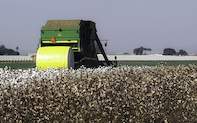The growth cycle of cotton is 160 - 180 days, depending on the cultivar, planting date, farming area and how long temperatures remain high. Flowering will occur from 70 days, peaking at 90 - 105 days with the first boll burst at 115 - 120 days after planting.

About three weeks after planting, cotton seedlings are thinned out. The spacing of cotton plants should be 70 000 - 88 000 plants/ha and up to 100 000 plants/ha under irrigation. Dryland farmers should plant to 50 000 - 70 000/ha (11 500 seed per kg). Too dense planting may lead to boll rot.
Danie Steyn, head technical officer at Loskop Ginnery in Marble Hall says most cotton fields are planted in rows from 76 cm to 91cm wide. The width depends on the type of cotton picker or stripper used. Small-scale farmers for handpicking will plant 91cm to 100cm wide rows.
The boll (cotton’s fruit) is the most important component of cotton production. Boll growth begins with pollination of the cotton flower. After pollination, the fibre matures and will continue until the pressure is such that the boll bursts. This results in a beautiful display of ‘snow covered’ cotton fields.
Cotton Management Practices
Various management practices can be employed to facilitate maximum yield and ease of harvesting. For example, a defoliant can be sprayed to remove cotton leaves. This ensures a cleaner crop and less vegetative material to be sorted out during the ginning process (to separate the cotton fibre from the seed).
Growth regulators are used to limit cotton plant growth and therefore rather channel nutrients to bolls and not to leaf growth. Plants should not grow higher than 700 - 800mm. Boll opening can be controlled by the use of hormones. Ethylene is primarily used. Sprays are also used to facilitate boll burst and growth regulators limit the height of cotton plants that will be machine harvested.
Weeds are managed with glyphosates. When glyphosate-resistant cotton cultivars are planted, these chemicals will not damage the growing cotton plant.
Cotton Harvesting

Seed cotton can be harvested by hand or machine. Depending on the yield, a 4-row picker (stripper) can harvest 70ha, while a 6-row picker should do 120 - 140ha in a season. When hand-picking cotton about 35 - 50 kg per day per person can be harvested. When handpicked, seed cotton is stuffed into wool bags, but when picked by machine, cotton is compressed into huge bales of 150 - 200 kg or square containers.
For mechanical cotton harvesting, the farmer should wait until at least 60% of the bolls have burst before harvesting the first (and often only) picking.
When hand-picking cotton, a second picking follows a few weeks after the initial main cotton harvest. The last bolls take longer to open because the physiological requirements to force bursting are reached much later. The timing of the second picking depends on the temperature and heat units.
Irrigation cotton could yield up to 6 tonnes/ha and more, but dryland conditions may only yield less than one tonnes to 3 tonnes per hectare. Small-scale farmers usually harvest less. These figures indicated are the yield for ‘seed cotton’ - cotton with its seed before the cotton fibres (lint) are separated from the cottonseed.
After harvesting, the seed cotton (packed in bales of 200 - 230 kg) is taken to a ginnery where the lint (fibre) is separated from the cottonseed.
Please note:
New cotton farmers are advised to consult technical advisors of cotton seed suppliers or Cotton SA for help regarding the correct cotton cultivar, planting time, growth and spraying schedules. Information supplied above is not to be construed as agricultural advice.
By Marinda Louw